
|   |

|   |
Dancing illusions - Ashish Mohan Khokar e-mail: khokar1960@gmail.com Photos: Supraja Srinivasan August 5, 2023 Stillness in dance is not easy to achieve. Dance is the art of motion and being still is an art beyond emotion. With training and experience, one can move easily on stage and depict technique or emotive dance but to be on stage and be still, is not easy. It comes from being centred. Unless one is at peace or spiritually evolved, it does not manifest easily. No amount of acting, acclaim or even awards can bring it. Guru Jigyasa Giri, director of Devaniya and the senior active Kathak dancer-guru of Chennai achieved that through this retelling of the epic tale of Mahabharata. Despite much action by many on stage, there was an overall stillness. It came from her being understated, quiet and dignified. Jigyasa Giri takes the Dakshin School / Gharana of Kathak forward. This school / gharana with moorings in South India (hence Dakshin) has come about in the last hundred years approximately. Gharanas (refer my column July 12, 2022 on narthaki and other books and attenDance issues attendance-india.com) were loosely structured schools of lineage, dovetailed due to provenance. Since so much is so quickly changing in this age of nano seconds, what earlier took four or seven generations to build is now done in three or four. The concept of generation itself has changed. From twenty years as one unit (four in a century) it is now 12-15 years per unit. Less is more! Wait another five years, AI will be writing this piece and a reader wouldn't know the difference. Having watched dance for last six decades, three stage productions on this theme of the Mahabharata have impressed one most. First was in 1974 in Kottakkal Arya Vaidya Sala, yes that Ayurveda place for medical treatment and meds. They maintained a regular Kathakali troupe and by way of evening entertainment, as there was no TV then, they had daily KK performances. Their presentations were basic but deep. There was just one lamp, no stage lights to watch under even. But it was magical. The next production on the Mahabharata I was mesmerized with was in 1985 in a dusty quarry we drove to in Avignon, France where Peter Brooks' Mahabharata unfolded over 9 nights! Yes, for nine nights daily people trudged to this quarry where an international theatre cast had assembled. That's 40 years ago. The best of Indian cultural scene people were there from India for the world premiere since Festival of India was on in France. Mallika Sarabhai was the only Indian in the cast as Draupadi. She could speak French better than the natives and was a dynamic actress to boot and trained in Kuchipudi and Bharatanatyam. To think today she heads the Kerala Kalamandalam as its Chairperson! The third show on the theme I was impressed with was Sonal Mansingh's mannequin- intensive act in the mid 1990s called Draupadi. Here's a strong one-woman army. Sonal Mansingh, not Draupadi or the Kauravas. She dominated the stage with her solo act and while the mannequin act of Nisar Alana was rather tame and comatose plastic bodies, Sonal Mansingh put life into even fibre plast! Today in 2023, guru Jigyasa Giri has achieved a scale that's majestic. Hers is a grand vision and production, with the split LED screens giving it depth. Royal interiors of palace shone and gave it the 3D effect. To transform a drab Narada Gana Sabha hall (with old velvet curtains and speakers covered in plastic sheets) itself is an achievement! The covered speakers perhaps muffled the sound also. Don't the owners of this hall, who earn much from it, see the overall shabbiness and lack of basic facilities and standards? 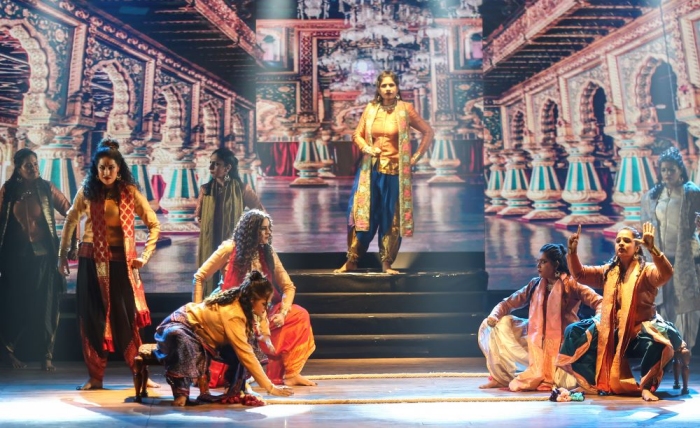 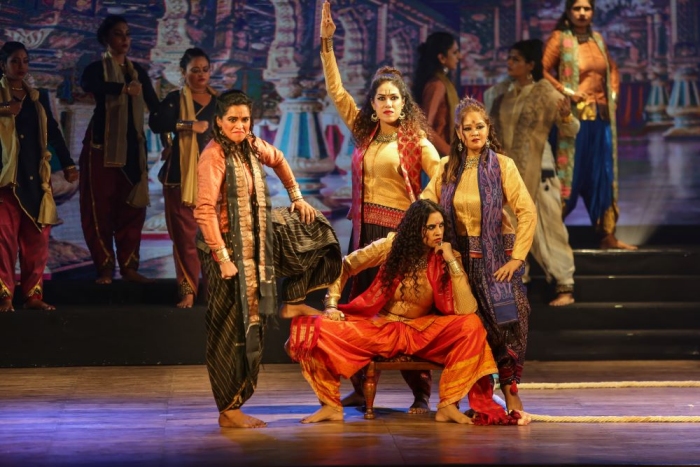 The strengths of the production are many: Excellent team work. Each character lived up to its role. The evil ones - Duryodhan (Preya Mani), Dushasan (Priya Lakshman), Karna (Sheeba Francis) and Shakuni (Priyadarshini Kandala) got maximum claps! Draupadi by Avani Maroo, all shine and glitter got much claps too. She added sheen to the production, though Draupadi is the only woman brought to court. It looked like an anomaly since the whole production had only females! Absence of male Kathak trained dancers was felt. Maybe due to economics again. For men, dance is not a paying enough occupation to run a home. The soldiers (Shruthi Rajaram, Meenakshi Srikrishna, Gigi Pramod, Keerthiga Ramachandran, Preethi Srikanth, Kavita Pancholi, Ikshika Sarode) formed the canvas of the story-telling and Dhritarashtra (Celita Babu) looked lost while Bhishma (Sridevi Padmanabhan) worked in tandem with Vidur (Archana Balu) to help foster the proceedings. Yudhishthar (Swetha Sundararajan) looked serene even when troubled. There was something saintly about this characterisation, even the end result robbed the brothers of their everything. The dice game was shown with clear demarcations. A rope was used, to establish boundaries of the game, within the huge court. One by one, Shakuni tricked Yudhisthira into pledging everything he possessed. Where Jigyasa Giri brought in a new touch was connect each "sacrificial" brother to concerns of today. So, losing Nakul meant losing a layer of life, like humans are facing climate change challenge. Losing Sahdev was connected to humanity, its lack of it. Loss of Bheema to the dice game denoted losing courage or valour for social causes, etc. In the end, dharma was lost when Draupadi was brought to the court and disrobing ordered. Very well scripted. The words were poetic and deep. Bheema (Anjali Kundalpadi) too achieved bhibasta mood just by one glance and flicker of eyes and hand gestures. Wish it were more clearly audible. There was an aural imbalance between the spoken word and the musical score. Also, all dancers don't have to be on stage all the time and commentary could be less too, as it's a constant drone. There's too much for the senses to see and absorb in one palette. Kathak in some way needed to be introduced right at the beginning so that form got established. 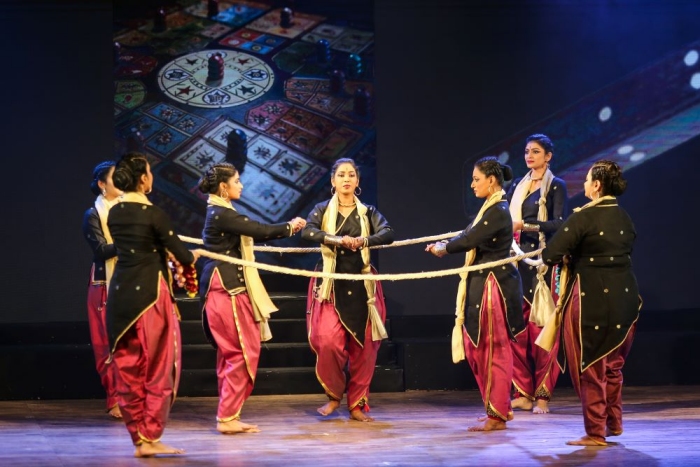 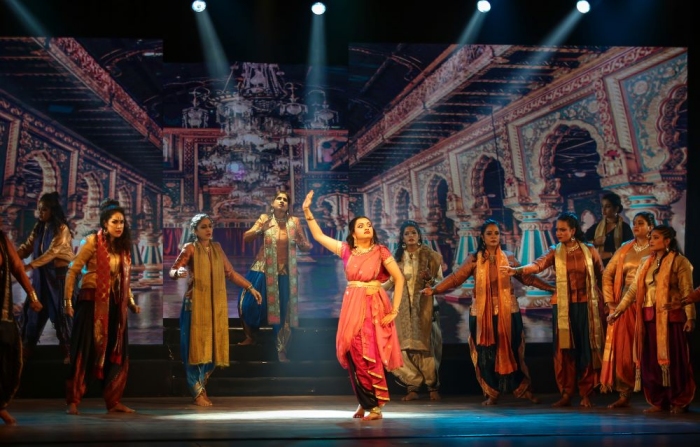 The second high marks go for music and third, for visuals. Music was powerful. The script was poetic. Jigyasa Giri has many talents and poetic, literary prose and script writing is one of them. Costumes had aesthetics and vibrant, appropriate colours like orange for Karna, since he was sired by Sun. Dark characters had dark costumes. Intelligent. Avani Giri as Krishna was a delight in the end, benign and royal at the same time. There's something very sabhya about her. Yudhisthira too was played with dignity and depth. Shankari as Arjuna was undertaken with aplomb. Energetic and dynamic. In the end one left the hall feeling the self-sponsored trip by train all the way from Bangalore to Chennai just to watch the show was worth it! The last line in the epic Mahabharata says it all: what's not stated here does not exist. Need more be said? 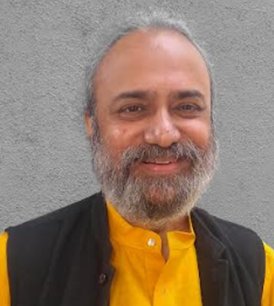 Critic, connoisseur, historian, author, artivist, archivist, administrator and more - editor, columnist and mentor Ashish Khokar remains true to his muse. More on attendance-india.com |